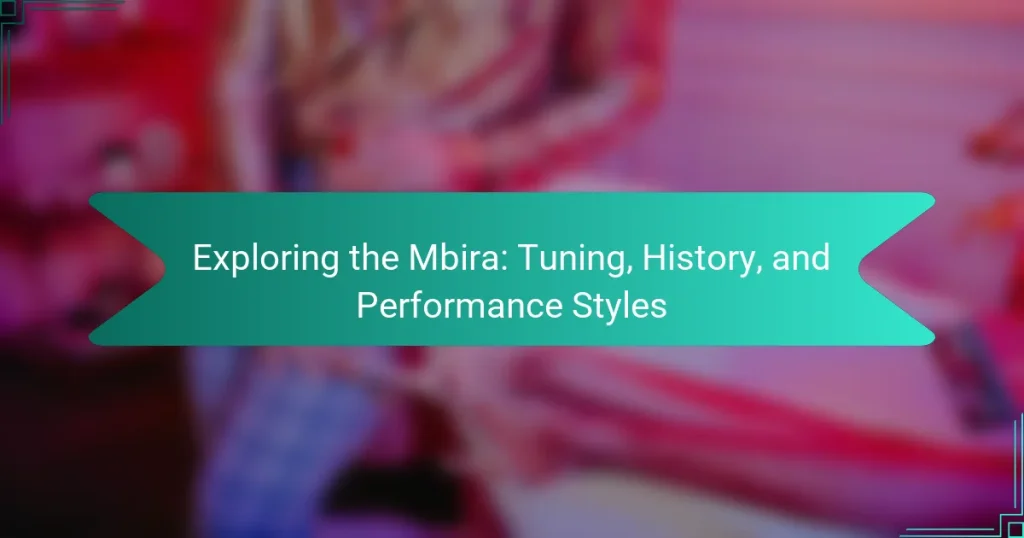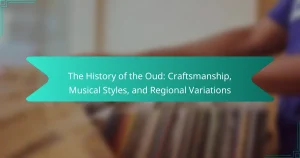The Mbira is a traditional African lamellophone, primarily associated with the Shona people of Zimbabwe. This instrument features metal tines mounted on a wooden board, often equipped with a resonator, and is played by plucking the tines with the thumbs. The article explores the Mbira’s rich history of over 3,000 years, its significant role in cultural ceremonies, and its unique melodic and rhythmic sound. It also examines various performance styles, including traditional, contemporary, and improvisational, while providing insights into learning techniques, such as understanding its structure, practicing finger techniques, and engaging with experienced players.

What is the Mbira?
The Mbira is a traditional African musical instrument, specifically a type of lamellophone. It consists of metal tines attached to a wooden board, often with a resonator. The instrument is played by plucking the tines with the thumbs. Originating from the Shona people of Zimbabwe, the Mbira is used in various cultural ceremonies and celebrations. Its music is often accompanied by singing and dancing. The Mbira has a rich history, dating back over 3,000 years. It is recognized for its unique sound, which is both melodic and rhythmic. The instrument plays a significant role in the spiritual practices of the Shona culture.
How is the Mbira constructed?
The Mbira is constructed using a wooden soundboard and metal tines. The soundboard serves as the resonating body, amplifying the sound produced by the tines. The tines are made from metal, typically of varying lengths, which affects their pitch. Each tine is attached to the soundboard using a bridge or a similar mechanism. The tines are plucked with the thumbs to create sound. The overall design can vary, with some Mbiras featuring additional resonators or decorative elements. Traditional Mbiras are often handcrafted, reflecting cultural significance and artistic expression. The construction method has been passed down through generations, ensuring authenticity in design and sound.
What materials are commonly used in making the Mbira?
The Mbira is commonly made from wood, metal, and gourd. The body of the Mbira is typically crafted from hardwood, providing durability and resonance. The tines, which produce sound, are usually made from metal, often steel or brass, for their tonal quality. Gourds are sometimes used as resonators to enhance sound projection. Historical practices indicate that traditional Mbiras were made from locally sourced materials, reflecting cultural significance. Specific woods like mahogany or baobab are favored for their acoustic properties. The combination of these materials contributes to the unique sound and character of the Mbira.
What are the key components of the Mbira?
The key components of the Mbira include the wooden board, metal tines, and resonator. The wooden board serves as the main body of the instrument. It typically has a flat surface that supports the tines. The metal tines are attached to the board and are plucked to produce sound. These tines vary in length and thickness, affecting pitch and tone. The resonator, often made from a gourd or other materials, amplifies the sound produced by the tines. Together, these components create the unique sound characteristic of the Mbira.
What is the historical significance of the Mbira?
The Mbira is historically significant as a traditional musical instrument in African culture. It has been used for centuries in rituals and ceremonies. The instrument is particularly important among the Shona people of Zimbabwe. It serves as a means of communication with ancestral spirits. The Mbira’s music plays a vital role in cultural identity and social gatherings. Its construction and tuning methods have been passed down through generations. The Mbira has also influenced contemporary music and art beyond Africa. Its recognition has expanded globally, symbolizing African heritage.
How has the Mbira evolved over time?
The Mbira has evolved significantly over time, adapting to cultural and musical changes. Originally, the Mbira was a traditional instrument in African communities, primarily used in spiritual ceremonies. Over the years, its construction has changed, with variations in materials and tuning systems. The introduction of metal keys replaced traditional wooden ones, enhancing sound quality and durability. Additionally, the Mbira has seen increased popularity outside Africa, influencing global music genres. This cross-cultural exchange has led to new playing techniques and styles. Today, the Mbira is not only a symbol of heritage but also a versatile instrument in contemporary music.
What cultures have influenced the development of the Mbira?
The Mbira has been influenced by various cultures, primarily from the Shona people of Zimbabwe. The Shona culture has a rich tradition of using the Mbira in spiritual and social contexts. Additionally, the influence of neighboring cultures, such as the Ndebele and the Tswana, has contributed to its development. Historical interactions through trade and migration have also played a role in shaping the Mbira’s evolution. The instrument’s significance in rituals and ceremonies underscores its cultural importance. Various styles of play and tuning have emerged from these cultural influences, enriching the Mbira’s musical heritage.
What are the different tuning systems of the Mbira?
The Mbira has several tuning systems. Common tunings include the Nyunga Nyunga, which is widely used in Zimbabwe. Another popular tuning is the Karimba, known for its melodic qualities. The 15-note tuning system is also prevalent, offering a rich harmonic structure. Additionally, there are variations like the 22-note tuning, which adds further complexity. Each tuning system influences the musical style and cultural context of the Mbira. The choice of tuning can affect the type of songs played and the emotional expression in performances.
How do tuning variations affect the sound of the Mbira?
Tuning variations significantly affect the sound of the Mbira. Different tunings produce distinct tonal qualities and emotional expressions. For example, a common tuning called “Kushaura” creates a bright, uplifting sound. In contrast, the “Kutsinhira” tuning offers a more melancholic tone. These variations influence the resonance and pitch of the instrument. They also determine the harmonic relationships between the notes played. Specific tunings can evoke different cultural contexts and musical styles. Thus, tuning is crucial for the Mbira’s versatility and expressive capabilities.
What are the most common tuning configurations used?
The most common tuning configurations used for the mbira include the following: the 7-note tuning, the 15-note tuning, and the 21-note tuning. The 7-note tuning is often referred to as the “Kushaura” tuning. It is frequently used in traditional Shona music. The 15-note tuning expands the range and allows for more complex melodies. The 21-note tuning offers even greater versatility in musical expression. These tunings are foundational to the mbira’s role in cultural performances. Research indicates that these configurations are integral to the mbira’s sound and its cultural significance.

What are the performance styles associated with the Mbira?
The performance styles associated with the Mbira include traditional, contemporary, and improvisational styles. Traditional styles are often rooted in cultural rituals and ceremonies, where the Mbira is played to accompany singing and dancing. Contemporary styles may incorporate modern influences and techniques, blending traditional sounds with new genres. Improvisational styles allow musicians to express personal creativity, often resulting in unique interpretations of melodies. These performance styles reflect the Mbira’s versatility and its role in various cultural contexts.
How is the Mbira played in traditional settings?
The Mbira is played by plucking its metal tines with the thumbs. Players often hold the instrument in a wooden frame, resting it on their laps. The Mbira is traditionally accompanied by singing and clapping. It is commonly used in ceremonies and social gatherings. The music produced is integral to cultural rituals. Different tunings create various musical scales. The performance style varies by region and community. Traditional players often learn through oral transmission from elders.
What are the typical performance contexts for the Mbira?
The typical performance contexts for the Mbira include traditional ceremonies, social gatherings, and spiritual rituals. In Zimbabwe, the Mbira is often played during ceremonies such as weddings and funerals. It serves as a medium for communication with ancestors. Social gatherings also see the Mbira as a central feature, fostering community interaction. Additionally, it is used in healing rituals to invoke spirits. The Mbira’s unique sound enhances these cultural experiences. Its role in these contexts underscores its significance in Zimbabwean heritage.
What role does the Mbira play in cultural rituals?
The Mbira plays a central role in cultural rituals among various African communities. It is often used in spiritual ceremonies to connect with ancestors. The sound of the Mbira is believed to facilitate communication with the spiritual world. Musicians play the instrument during rites of passage, healing ceremonies, and celebrations. The Mbira’s music sets the atmosphere for these significant events. It also serves as a medium for storytelling and cultural transmission. In many traditions, the Mbira is considered sacred and is treated with great respect. Its presence in rituals underscores its importance in maintaining cultural identity and heritage.
What modern adaptations of Mbira performance exist?
Modern adaptations of Mbira performance include fusion with contemporary music genres. Artists blend traditional Mbira sounds with jazz, pop, and electronic music. This fusion creates innovative soundscapes while preserving cultural significance. Collaborative performances often feature Mbira alongside instruments like guitar and drums. Additionally, some musicians incorporate vocal elements and storytelling into their performances. These adaptations reach broader audiences and enhance cultural exchange. Events like festivals showcase these modern interpretations, highlighting their evolving nature. The use of technology in recordings and performances further modernizes Mbira music.
How have contemporary musicians incorporated the Mbira into their work?
Contemporary musicians have incorporated the Mbira into their work by blending its traditional sounds with various modern genres. Artists like Stella Chiweshe and Tanyaradzwa Tawengwa have utilized the Mbira in world music and fusion genres. They often combine Mbira melodies with electronic beats and instruments. This fusion creates a unique sound that appeals to diverse audiences. Additionally, musicians use the Mbira in live performances to enhance cultural storytelling. Collaborations with artists from different backgrounds further expand its reach. The Mbira’s incorporation into contemporary music also promotes awareness of Zimbabwean culture. This trend reflects a growing appreciation for traditional instruments in modern music.
What fusion genres feature the Mbira prominently?
The Mbira prominently features in several fusion genres. These include Afrobeat, which blends traditional African music with jazz and funk elements. Additionally, world music often incorporates the Mbira, creating a mix of various cultural sounds. Another genre is electronic music, where artists use the Mbira to add organic textures to their tracks. Furthermore, reggae music sometimes integrates the Mbira, enhancing its rhythmic foundation. Each of these genres showcases the Mbira’s versatility and cultural significance.

How can one learn to play the Mbira effectively?
To learn to play the Mbira effectively, one should start by understanding its structure and tuning. The Mbira typically consists of metal tines attached to a wooden resonator. Familiarizing oneself with the specific tuning of the Mbira is crucial, as different tunings produce distinct sounds.
Next, practicing finger techniques is essential. Players use their thumbs and sometimes other fingers to pluck the tines. Regular practice helps develop muscle memory and improves coordination. Listening to traditional Mbira music can also provide insights into rhythms and styles.
Engaging with a teacher or joining a community can enhance learning. Experienced players can offer guidance and feedback. Participating in workshops or online tutorials can provide structured learning paths.
Finally, consistent practice is key to mastery. Setting aside time daily for focused practice can lead to significant improvement over time.
What resources are available for beginners learning the Mbira?
Beginners learning the Mbira can access a variety of resources. Online tutorials are available on platforms like YouTube. Websites dedicated to African music often provide instructional videos and sheet music. Books on the Mbira, such as “The Mbira: An African Musical Instrument” by Paul F. Berliner, offer detailed insights and techniques. Local music schools may also offer classes specifically for the Mbira. Additionally, community workshops often provide hands-on learning experiences. Social media groups focused on Mbira enthusiasts can facilitate peer learning and support. These resources collectively enhance the learning experience for beginners.
What techniques should beginners focus on first?
Beginners should focus on basic finger techniques and proper posture first. Mastering finger techniques involves learning how to pluck the tines effectively. Proper posture ensures comfort and facilitates better sound production. Beginners should also practice simple melodies to build confidence. Additionally, understanding the mbira’s tuning is crucial for producing harmonious sounds. Familiarity with the instrument’s layout helps in navigating its tines efficiently. These foundational skills are essential for progressing to more complex playing styles. Research indicates that early focus on these techniques leads to improved overall performance.
How can practice routines enhance Mbira playing skills?
Practice routines can significantly enhance Mbira playing skills through structured repetition and focused techniques. Regular practice helps develop muscle memory, allowing players to execute complex patterns effortlessly. Consistent routines also improve timing and rhythm, essential elements in Mbira music. Additionally, practicing specific techniques, such as plucking and damping, leads to greater control over sound quality. Engaging in daily practice can increase familiarity with various scales and tunings used in Mbira. Research indicates that musicians who follow structured practice regimens show marked improvements in performance over time. Thus, dedicated practice routines are crucial for mastering the intricacies of Mbira playing.
What tips can improve performance on the Mbira?
To improve performance on the Mbira, practice regularly to build muscle memory and familiarity with the instrument. Focus on maintaining proper hand positioning to enhance sound clarity. Use a metronome to develop timing and rhythm skills. Experiment with different techniques, such as plucking and damping, to create varied sounds. Listen to recordings of skilled Mbira players to understand different styles and techniques. Record your practice sessions to identify areas for improvement. Engage with a community of Mbira players for tips and feedback. Lastly, ensure the instrument is properly tuned for optimal sound quality.
How can one develop a personal style while playing the Mbira?
To develop a personal style while playing the Mbira, one should focus on improvisation and individual expression. Experimenting with different rhythms can help create a unique sound. Incorporating personal emotions into the music enhances authenticity. Learning various traditional pieces provides a foundation for creativity. Listening to diverse Mbira players can inspire new techniques. Regular practice allows for refinement of personal techniques. Engaging with the cultural context of the Mbira enriches understanding and style. Personal style evolves through continuous exploration and adaptation.
What common challenges do players face when learning the Mbira?
Players face several challenges when learning the Mbira. One common challenge is mastering the finger techniques required for playing. The Mbira requires precise plucking of the metal tines, which can be difficult for beginners. Another challenge is understanding the tuning systems used in Mbira music. Different Mbira types have unique tunings that players must learn to navigate. Additionally, players often struggle with the rhythmic patterns that are integral to Mbira music. These patterns can be complex and require practice to internalize. Cultural context is also a challenge, as understanding the music’s origins enhances playing but may be unfamiliar to some learners. Lastly, physical discomfort can arise from playing the instrument for extended periods, leading to fatigue or strain.
The Mbira is a traditional African lamellophone, integral to the cultural heritage of the Shona people of Zimbabwe, known for its unique melodic and rhythmic sound. This article explores the construction, materials, and historical significance of the Mbira, detailing its role in cultural rituals and contemporary adaptations. Key components, tuning systems, and performance styles are discussed, alongside techniques for learning and common challenges faced by players. The article highlights the evolution of the Mbira over time and its influence on modern music genres, providing a comprehensive overview of this significant musical instrument.




